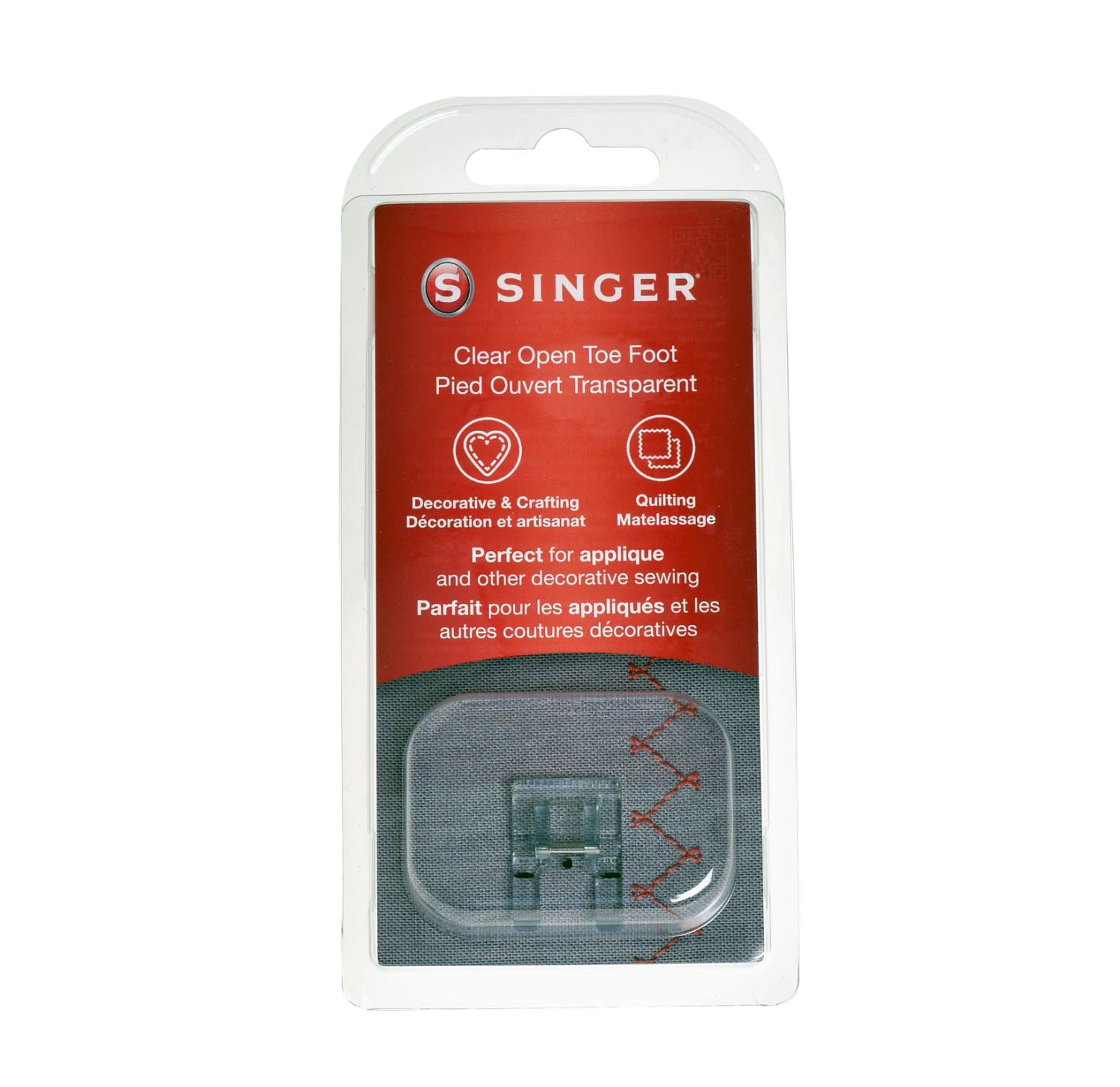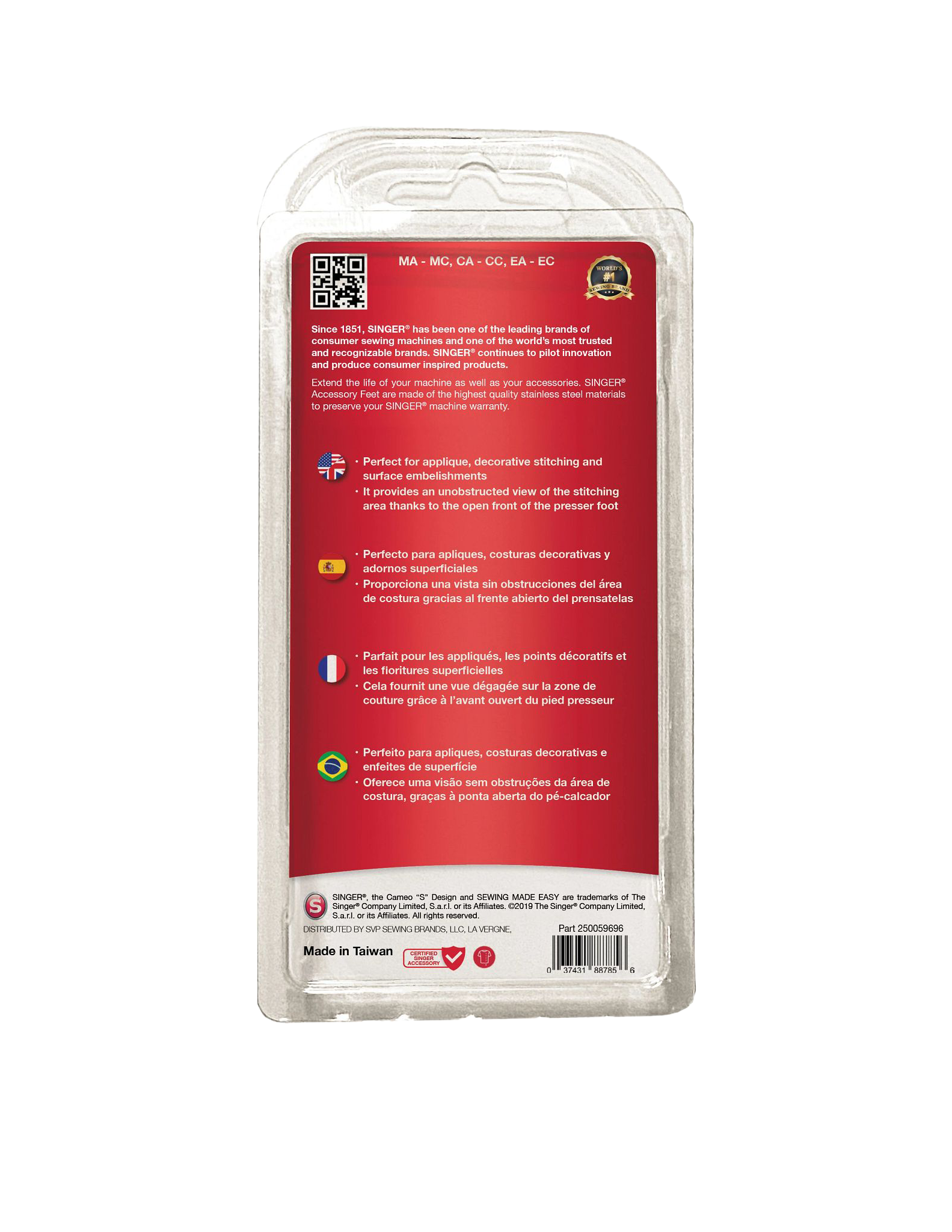Perfect for applique, decorative stitching and surface embellishments. It provides an unobstructed view of the stitching area thanks to the open front of the presser foot.
Appliqués
Appliqués are shaped pieces of fabric sewn onto a foundation fabric to form a design or pattern. The most popular method for attaching an appliqué is with satin stitch, (a zigzag stitch with a shortened stitch length.) Other stitches may also be used, such as the pin stitch, blanket stitch and blind stitch. Attach an appliqué by stitching over the edges of the applique shape. For satin stitch, make sure the right swing of the needle is just over the raw edge of the appliqué shape and the left swing of the needle is within the appliqué shape. For a hand sewn look, use blanket stitch or blind stitch sewing. Try using a different thread with the blanket stitch for a vintage feel. Set stitch length and width proportionate to the appliqué size and the look you want for your project.
Decorative Stitching
The Open Toe Foot works well for decorative stitching because the tunnel on the underside of the foot allows the stitches to feed smoothly under the foot. Use a fabric marking tool to mark a guideline on the right side of your fabric for stitching. Place a piece of stabilizer under the fabric, select the desired stitch and start sewing. Follow the stitching guideline on your fabric. Once you have completed the decorative stitching, follow the fabric marking tool manufacturer’s instructions for how to remove guideline marks on your fabric. You can experiment with different threads and stitch settings to create the perfect look for your project. Note: Stabilizer under your fabric can help the stitches stay smooth and prevent puckering.
Surface Embellishment
The Open Toe Foot is useful when applying ribbons, yarns or trims to fabric surfaces. The foot allows you to easily guide the trim while stitching because of the generous viewing area and the groove under the foot. You may wish to mark a guideline mark on the right side (top side) of your fabric. Place a layer of stabilizer under the fabric. This may help prevent any puckering of the fabric when you sew. Select a decorative stitch or zigzag stitch and set the stitch width wide enough to cover the ribbon. Guide the ribbon under the presser foot to apply it to your fabric and start stitching. You can vary the decorative stitches used on the same project for unique combinations.
Tip: Experiment with different decorative stitches and try changing the width according to the trim you are using.
Topstitching
Provides a clean, professional look. Commonly used on garment edges such as necklines, hems and pockets or on edges of other projects such as bags, pillows and curtains. Use the inside edge of the Open Toe Foot as an easy-to-see topstitching guide. Place the finished edge or seam line under the presser foot so that the right toe of the footrests on the finished edge or seam line.
Stained Glass Quilting
Create the intricate look of stained glass with fabric and bias trim. The Open Toe Foot is helpful when creating stained glass quilting because the open area of the foot allows the bias tape to be easily guided while stitching. Use fusible web to apply fabric pieces to a foundation fabric. Cut the shapes so that they cover a foundation fabric piece, either white cotton or cotton muslin, completely. Using a zigzag or blanket stitch sew 1/4” bias tape over the raw edges of the fabric pieces, covering them. Try this technique with fabric scraps and different geometric shapes. Or embellish your fabric pieces with decorative sewing machine stitches before sewing into the quilt.
Reverse Bobbin Work
Embellish fabric for children’s clothing, home decor and more with reverse bobbin work. Wind a bobbin with pearl cotton by hand. Use a moderate amount of tension, not too loose, not too tight. Thread the bobbin without taking the thread into the bobbin tension. Stitch onto your fabric using your favorite decorative stitch with the correct, face side of the fabric facing the feed dogs.
Because the decorative thread is now in the bobbin, you will need to work in 'reverse'! Apply a lightweight stabilizer to the wrong side of the fabric before you begin sewing. You may find it helpful to draw stitching guidelines on the wrong side of the stabilized fabric first. This will be the side facing you as you sew, because the right side (top side) of the fabric will be facing the feed dogs. Choose stitch patterns that are more open in design, rather than thicker or denser stitches which may tend to bunch up underneath because of the thickness of the bobbin thread.
When finished, gently remove excess stabilizer. Bring both threads to the wrong side of the fabric and tie off to secure. Choose stitch patterns that are more open in design, rather than thicker or denser stitches which may tend to bunch up underneath because of the thickness of the bobbin thread. When finished, gently remove excess stabilizer. Bring both threads to the wrong side of the fabric and tie off to secure.
Compatible Machines












